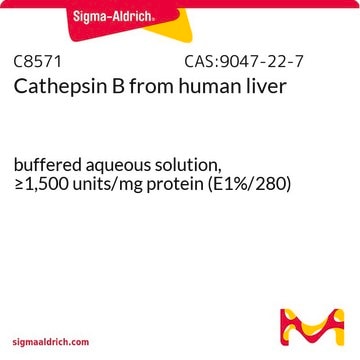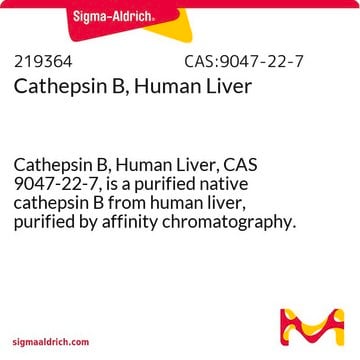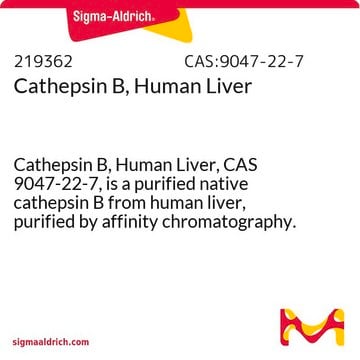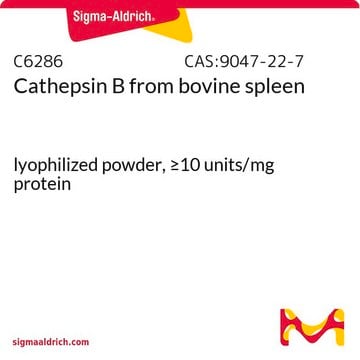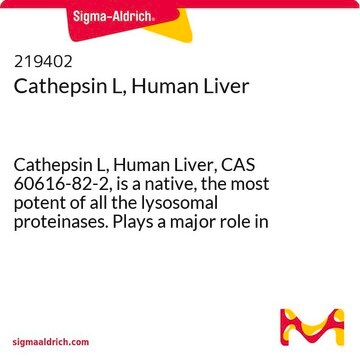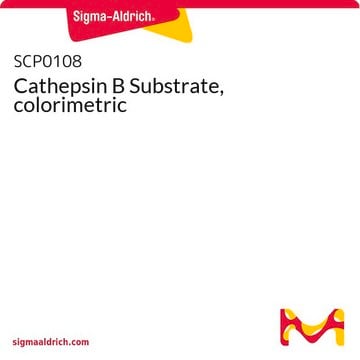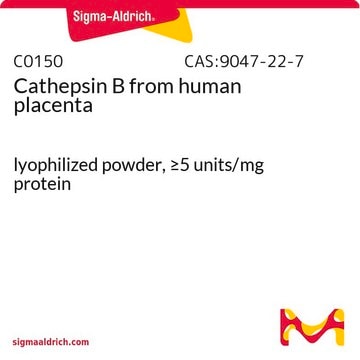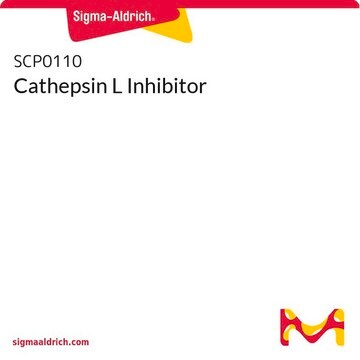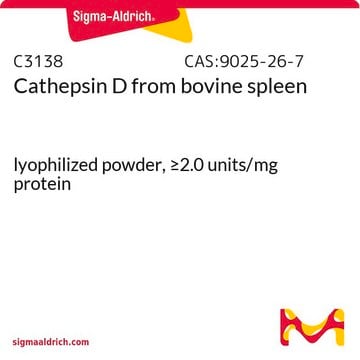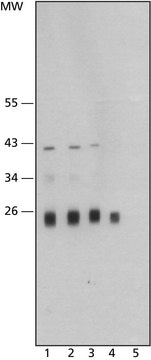C6854
Cathepsin L from human liver
≥0.5 units/mg protein, solution
Sign Into View Organizational & Contract Pricing
All Photos(1)
About This Item
CAS Number:
MDL number:
UNSPSC Code:
12352200
NACRES:
NA.32
Recommended Products
biological source
human liver
Quality Level
form
solution
specific activity
≥0.5 units/mg protein
technique(s)
activity assay: suitable
pH range
4.5—5.5
UniProt accession no.
application(s)
pharmaceutical
shipped in
dry ice
storage temp.
−20°C
Gene Information
human ... CTSL1(1514)
General description
The cathepsin L (CTSL) gene is mapped to human chromosome 9q21.33. It encodes a lysosomal cysteine proteinase that belongs to the peptidase C1 family. The enzyme is a dimer of a heavy (175 amino acids) and a light chain (42 amino acids) linked by disulfide bonds.
Application
Cathepsin L (CTSL) from human liver has been used:
- to digest mutant transforming growth factor β-induced (TGFBIp) and LC3 (autophagosomes marker) proteins in vitro
- to digest the pH-dependent fibril of a pre-melanosomal protein (Pmel17) repeat domain (RPT) isoform and study the effect of pH on sRPT aggregation kinetics by tryptophan fluorescence
- to analyze the inhibition of CTSL by small molecules or drugs in a cell-free system
Biochem/physiol Actions
Cathepsin L (CTSL) exhibits endopeptidase activity and breaks peptide bonds with aromatic residues. This enzyme is functional at pH 3.0–6.5 with thiol compounds. Elastin, collagen, and α-1 protease inhibitors act as substrates for cathepsin L (CTSL). CTSL cleaves several proteins including enzymes, receptors, and transcription factors. It is involved in antigenic peptide production and controls B-cells homeostasis. It is associated with myofibril necrosis and tumor progression. Increased expression of CTSL promotes metastasis and relates to poor prognosis in cancer patients. Increased expression of CTSL is observed in breast cancer. CTSL is implicated in glioblastoma multiforme (GBM), middle east respiratory syndrome (MERS), gingival overgrowth, and severe acute respiratory syndrome coronavirus 2 (SARS-CoV-2). It has a higher specific activity than cathepsin B and H in the degradation of a variety of physiological protein substrates.
Unit Definition
One unit will hydrolyze 1.0 μmole of Z-Phe-Arg-AFC per minute at pH 5.5 at 25 °C.
Physical form
Solution in in 20 mM malonate, pH 5.5, 1 mM EDTA, and 400 mM NaCl.
Storage Class Code
10 - Combustible liquids
WGK
WGK 3
Flash Point(F)
Not applicable
Flash Point(C)
Not applicable
Certificates of Analysis (COA)
Search for Certificates of Analysis (COA) by entering the products Lot/Batch Number. Lot and Batch Numbers can be found on a product’s label following the words ‘Lot’ or ‘Batch’.
Already Own This Product?
Find documentation for the products that you have recently purchased in the Document Library.
Customers Also Viewed
Stefan Tholen et al.
Cellular and molecular life sciences : CMLS, 71(5), 899-916 (2013-07-03)
Endolysosomal cysteine cathepsins functionally cooperate. Cathepsin B (Ctsb) and L (Ctsl) double-knockout mice die 4 weeks after birth accompanied by (autophago-) lysosomal accumulations within neurons. Such accumulations are also observed in mouse embryonic fibroblasts (MEFs) deficient for Ctsb and Ctsl.
M Kathryn Liszewski et al.
Immunity, 39(6), 1143-1157 (2013-12-10)
Complement is viewed as a critical serum-operative component of innate immunity, with processing of its key component, C3, into activation fragments C3a and C3b confined to the extracellular space. We report here that C3 activation also occurred intracellularly. We found
Dexter N Dean et al.
Biochimica et biophysica acta. Proteins and proteomics, 1867(10), 961-969 (2019-02-05)
The pre-melanosomal protein (Pmel17) aggregates within melanosomes to form functional amyloid fibrils that facilitate melanin polymerization. The repeat domain (RPT) of Pmel17 fibrillates under strict acidic melanosomal pH. Alternative splicing results in a shortened repeat domain (sRPT), which also forms
Gustavo E Chavarria et al.
European journal of medicinal chemistry, 58, 568-572 (2012-11-22)
Kinetic analysis of the mode of inhibition of cathepsin L by KGP94, a lead compound from a privileged library of functionalized benzophenone thiosemicarbazone derivatives, demonstrated that it is a time-dependent, reversible, and competitive inhibitor of the enzyme. These results are
Bailey Miller et al.
Journal of natural products, 77(1), 92-99 (2013-12-25)
A number of marine natural products are potent inhibitors of proteases, an important drug target class in human diseases. Hence, marine cyanobacterial extracts were assessed for inhibitory activity to human cathepsin L. Herein, we have shown that gallinamide A potently
Our team of scientists has experience in all areas of research including Life Science, Material Science, Chemical Synthesis, Chromatography, Analytical and many others.
Contact Technical Service